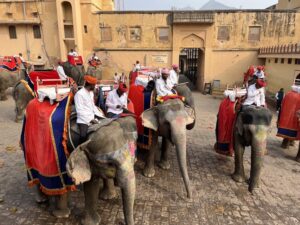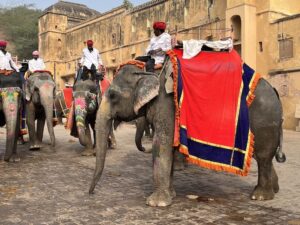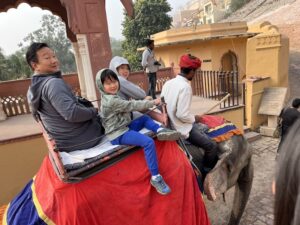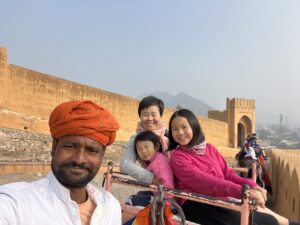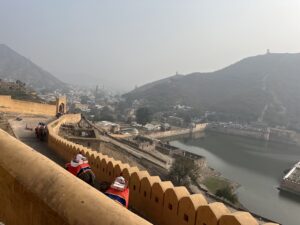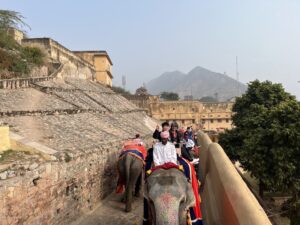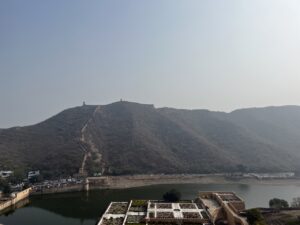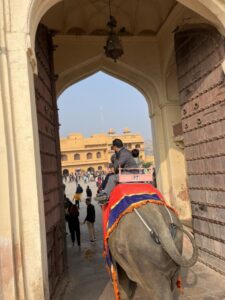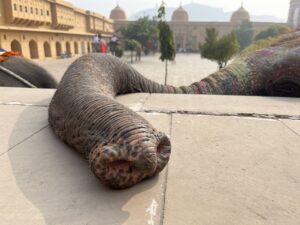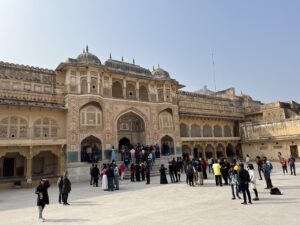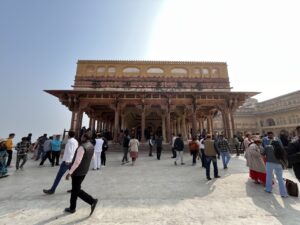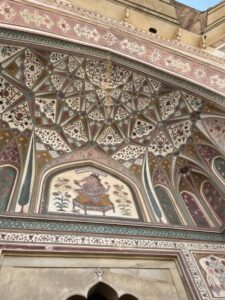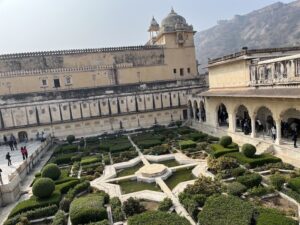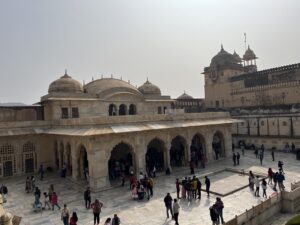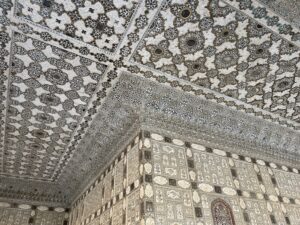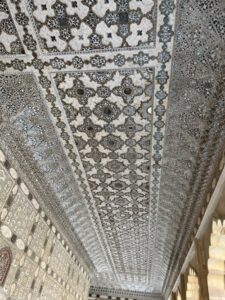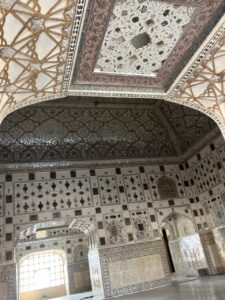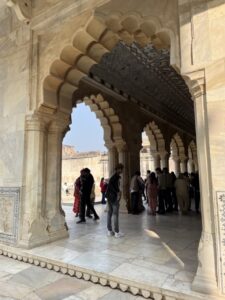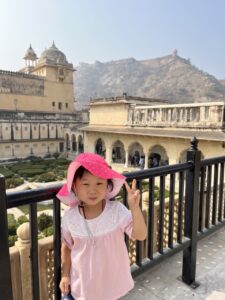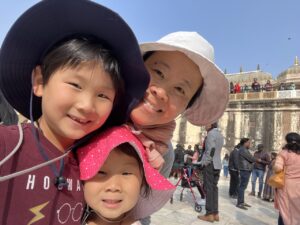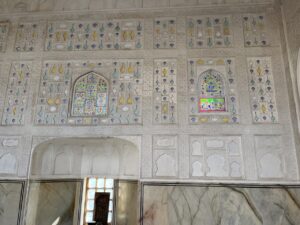A few days prior to our visit to Amber Fort, Rajesh asked me if we wanted to ride the elephants up the hillside to the entrance of the fort. The alternative to riding the elephants would be to go by jeep or walk. I debated back and forth about whether to sign up for the elephant ride. We consider ourselves to be animal lovers and we try to be cognizant of animal welfare when we travel. On the one hand, I kind of sort of wanted us to have the quintessential experience of riding an elephant in India. It’s silly, but in my mind was the picture of the maharajah riding in a howdah atop a decorated and bejeweled elephant.
On the other hand, maybe (or probably) it is cruel to ride on the back of an elephant. Elephants are extremely intelligent and social animals. I thought about the wild elephants that we saw in Kenya and South Africa. We spent some time observing a herd of elephants in Amboseli National Park when they came to drink at a waterhole within view of our open-air living room (read about it here). I watched a mother elephant who in turn watched her baby play in muddy puddles. Our Maasai guide told us that elephants have incredibly good memories and told us a true story of a herd that visited the same tree around the same date every year to mourn and memorialize the death of one of their family members.
Maybe what the animal rights activists say is true. Maybe the elephants were taken away from their mothers when they were babies. Maybe they were beaten when they misbehaved. Maybe they would only be obedient once their spirit was broken. Maybe they didn’t get enough to eat and were worked to the point of exhaustion.
But maybe the people who depended on the elephants for their own livelihood realized that a healthy and well-fed elephant was worth more than a sick and frail elephant. Maybe the money they earned went to feeding and caring for the elephants. If they didn’t have income, there would be no money for food. Maybe the handlers had some affection for the elephants after a lifetime of working together. Maybe a working elephant generating income was in a better position than an idle elephant with no obvious value to humans. Maybe carrying a couple people weighing no more than a few hundred pounds up to Amber Fort wasn’t so difficult for an elephant.
I hoped for the best, but maybe it was a mistake. The choice weighed on my conscience. I think next time, I would choose differently.
We climbed onto the saddle of the elephant from a tall ledge. Being nearly 2.5 meters off the ground made us feel vulnerable. The saddle was slanted and quite uncomfortable. The mahout (handler) was friendly and we did not see him hit, whip or inflict any violence upon the elephant. When he wanted the elephant to move forward, he used his foot to press behind the elephant’s ear. We zigzagged our way up the side of the hill leading to the fort. On the way up, the mahout offered to take some photos and make a video for us.
The views were spectacular and it did feel special approaching the fort on the back of an elephant, especially passing through the Suraj Pol (Sun Gate) into the main courtyard of the fort. This is where victorious warriors would gather to display their spoils of war. The ladies of the royal family and the court could view the processions through the lattice windows of the palace.
Built of white and red sandstone, Amber Fort was originally constructed by Raja Man Singh in 1592 and added to over the next several hundred by successive rulers over the next 150 years. The fort is organized into four courtyards.
We walked up the stairway from the first courtyard to the second courtyard. In the second courtyard are two great open-air buildings where the king conducted official business. In the Diwan-e-Aam (Hall of Public Audience), the king had an open audience where members of the general public could air grievances, file complaints or make requests directly to the king. The Diwan-e-Khaas (Hall of Private Audience) is where the king conducted state business related to the kingdom with relevant ministers in attendance. The king also received esteemed state guests such as ministers and representatives from other kingdoms.
We entered the third courtyard through the Ganesh Pol, featuring a beautiful inlay mosaic of the Lord Ganesha and floral motifs.
The third courtyard contains a patterned Mughal garden called Char Bagh and the most famous hall in all of Amber Fort, Sheesh Mahal (Mirror Palace) built by Raja Man Singh II in 1727. The walls of the Sheesh Mahal are covered from top to bottom, including the ceiling, with concave mirrors. Due to the clever design, the entire hall can be illuminated by just two candles, appearing as if there are a thousand points of light inside the room. Legend has it that the Sheesh Mahal was built by the king who ordered his architects to make a room that would allow the queen to see the stars in the sky without sleeping outside. The room was cordoned off, not allowing tourists to step into it, so everybody crowded around and took pictures from the outside.
Also in the third courtyard were the king’s private quarters, Sukh Niwas (Hall of Pleasure). The inner wall of Sukh Niwas is decorated with an intricate design of recessed wall patterns and colored glass in the shape of various vessel forms. This room was once “air-conditioned” by a channel along the wall that carried cool water from Maotha Lake through the room.
The fourth courtyard, containing the Zanana Dyodhi, was separated from the rest of the fort because it was the residence of the royal women. The queen, wives, children, ladies of the court and their attendants spent most of their time in this area of the palace. We did not go inside but viewed it from a distance.
As we were wandering through the palace, EY and I saw a few other people taking pictures through the stone lattice windows. We watched them do it and gave it a try ourselves.
Amber Fort was another visually stunning and fascinating example of Indo-Islamic architecture and design. Hindu gods like Lord Ganesha were juxtaposed beside Muslim elements like lattice windows, dramatic archways and geometric designs in the marble inlay. The fusion of these elements came together to create a uniquely Mughal aesthetic that is not only beautiful but a reflection of the political climate of the time. The Rajput kings and the Mughal rulers forged alliances and inter-married to fortify their own sphere of power and ensure their political survival. These sometimes complicated relationships manifested in physical form for all to see in the architecture and art of the Mughal empire.
Author
-

Song is the mother of four children. She and her family have stepped away from it all and in September 2023, began traveling the world while homeschooling. Song is an ABC (American born Chinese) and has an undergraduate degree from Cornell and an MBA from Harvard. She is an entrepreneur and an educator. Her hobbies include learning, traveling, reading, cooking and baking, and being with children.


